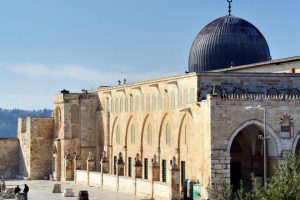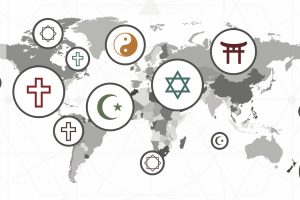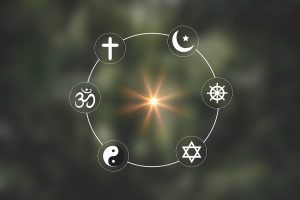Some of the most frequent and prominent gatherings throughout the year are those of various religious communities. The current spread of COVID-19 has noticeably altered such routine gatherings all around the world, forcing religious and community leaders to alter their approach. The Review of Religions interviewed a Rabbi from the United States, a Priest from the United Kingdom and an Imam from Canada to see how they and their communities are adjusting to the current state of affairs.

The world is going through turbulent times. Unsurety abounds as people desperately look towards leading health experts and political leaders to give any positive news towards a brighter future. But these aren’t the only institutions that people are turning to.
The Angus Reid Institute reports that one-in-five Canadians say that they or people close to them have been supported by a faith institution since the start of the Coronavirus pandemic’s spread.[i] Similarly, a poll conducted by the Pew Research Association in the United States shows that more than half of U.S. adults are praying for an end to the Coronavirus. In fact, 36% of those who do not necessarily identify with religion at all say they have also prayed for an end to this pandemic.[ii] An increased inclination towards religion and prayer seems to have become a worldwide trend. It is reported that as of March 2020, internet searches for ‘prayer’ have surged to the highest level over the past five years.[iii]
These trends show that religion is playing a vital role in people’s lives, especially during this time of crisis. But this time of crisis has also impacted the way in which religious communities operate. Maulana Shahrukh Abid, an Imam for the Ahmadiyya Muslim Community in Brampton Canada says:
‘By not being able to come together physically, unfortunately we have had to postpone or cancel many events. However, we have shifted our focus to holding our activities online. We use platforms such as Zoom and Google Hangouts to keep our members engaged. Within that, we continue to discuss current affairs, hold religious knowledge classes for kids and various relevant topics.’
It’s an alternative being used by faith-based groups around the world. With physical distancing restrictions being enforced, the only way to keep communities together seems to be through technology. But as Reverend Deborah Forman of the St. Mary the Blessed Virgin Church in Addington UK explains, being physically unable to convene at places of worship is a significant change,
‘We are unable to use the church building and gather there for worship. That is a big change for people as not only can they not worship in the way to which they are accustomed but they are also not able to enjoy fellowship afterwards and for some who live on their own that will have a significant impact. So, there are both spiritual and social aspects to these restrictions.’
The aspect of community which comes about especially through religious gatherings is undoubtedly a focal point, yet something which technology cannot replicate, especially for the older generation. Rabbi Manes Kogan from the Hillcrest Jewish Center in Queens New York, USA says,
‘While we have services and classes through Zoom, it is not the same. Many of our older members don’t feel comfortable using computers or don’t have computers, so their interaction with other members is very limited.’
But the fact that these restrictions have limited communal religious gatherings to our screens isn’t entirely negative, as Rabbi Kogan explains,
‘It is very challenging but at the same time, it opens new opportunities to connect with people. For example, we found out that some people who didn’t come to study or pray in person, enjoy doing it through Zoom. We are learning what works and what doesn’t on the march.’
It’s this mindset of marching forward which all religious leaders and figures are having to employ, now more so than ever. This pandemic has struck at a time when some of the most prominent and important religious festivals take place.
Rabbi Kogan describes that there was a noticeable difference during Passover this year. The usual traditional community Seder (feast) which draws an attendance of around 150 people comprising of mostly those who live on their own, could not take place. Families had Seders at home, some using Zoom to join with other family members. ‘Thank God for technology,’ says Rabbi Kogan. ‘It was OK but not the same.’
The sentiment is similar from Reverend Forman, who just celebrated the Holy Week and Easter, having to stream services from home, ‘We must be grateful to new technologies which have enabled us to live stream services from our homes but there are some significant differences.’ Services such as those of Palm Sunday (the Sunday before Easter) or the liturgy on Good Friday were able to be streamed online, but some of the physical aspects of these services could not be observed, which made a noticeable difference; whether it was not being able to receive divine communion or physically venerating the cross. Despite these differences, Reverend Forman says that there were some positive aspects to be taken away,
‘Often this is a busy time with people arranging flowers and changing candles and checking on the liturgy and something of that deep emptiness is lost. This year there were no frantic preparations, simply a profound stillness until late in the evening when the Easter Vigil began in my home with passages of scripture before going outside to light the Easter Candle, bring it back inside, greet it with the joyful Exsultet and then move into the first Eucharist of Easter.’
For Muslims, Ramadan has already started. It’s a time when people gather in mosques on a daily basis, even more than usual. Congregational prayers see an increase in attendance while various classes for teaching the Holy Qur’an are held. But as this much anticipated time of the year has arrived, Imam Shahrukh Abid sees there being a significant difference,
‘There will not be any gatherings in the mosque – we’re probably going to have to spend all of Ramadan at home. As a Missionary, I will be conducting dars (class) online for the members. Even if Ramadan is spent at home, we have to make sure to benefit from this month and not allow COVID-19 to impact our efforts in any way.’
Things such as fasting, prayer, study of the Holy Qur’an, and reflection will largely go unaffected as these things can also be done at home. Even congregational prayers can still be offered at home with family, providing an opportunity for households to come even closer together in prayer and worship,
‘I’ll be home I’ll have more of an opportunity to spend time at home with my wife and son, and have an opportunity to pray with them.’
In fact, Imam Abid sees the coming of Ramadan at this particular time to be most opportune, as it gives members of the Ahmadiyya Muslim Community an excellent opportunity to act upon the guidance given in these times by the Caliph, Hazrat Mirza Masroor Ahmad (aba),
‘His Holiness (aba) has repeatedly instructed us to pray for the current situation of the world, Ramadan is an excellent opportunity to pray for the world; that Allah may remove this distress.’
As this holy time of the year approaches, Imam Abid and his community are doing their best to make sure everyone is taken care of,
‘We have contacted all the members of the community to make sure that they are well and equipped to deal with this pandemic. We offer any help that they may require. We also work alongside Humanity First (a non-profit organization) to provide for those in need with essential items. Of course we do all this while carefully following the precautionary guidelines given to us by health officials.’
Although it’s not the same, it is the reality at hand. Faith and community leaders are doing all they can under the circumstances to provide as much normalcy as possible, and be there for their communities, even if there is an obvious difference, as Rabbi Kogan says, ‘while we can supply somehow the religious aspect of the synagogue role, the social role is affected.’
The efforts of these leaders do not go unnoticed by those who look to them for guidance and comfort. Reverend Forman does what she can to keep the members of her church engaged,
‘One of the things that is not possible at the moment is pastoral visiting and this is a source of great sadness. I have been able to keep in touch on the telephone and in some cases using zoom but one is deprived of the clues that tell you how a person really is when you are in their presence. The positive side of this is that I have probably contacted more people than I would have been able to physically visit in the same time frame and I know this is appreciated.’
It’s efforts like those being made by Rabbi Kogan, Reverend Forman and Imam Abid that are helping religious adherents stay engaged and connected in this most trying time. If global trends are any indication, then these same efforts are being replicated throughout the world. As research shows, these times are leading more and more people to focus on prayer. Jeanet Bentzen from the University of Copenhagen writes,
‘The rise in prayer intensity supersedes what the world has seen for years. The COVID-19 is still far from its’ peak and it only just reached the developing world. Furthermore, as more and more people loose their loved ones, the demand for religion is likely to rise. It is there highly likely that the rise in prayer intensity will continue.’[iv]
As this focus on prayer and religion continues, these leaders will be there for their communities, providing guidance and hope; the central theme of Reverend Forman’s message to her community,
‘We have hope, hope that through the darkness of this time, we shall come to that light which can never be extinguished and that through it the doors of our hearts will be opened in a new way. Let us live through these dark times with deep resurrection joy in our hearts and compassion in all our words and ways.’
When it comes to providing a guiding light for his community, Imam Shahrukh Abid has a powerful, poignant message,
‘Regarding Khilafat {Caliphate] the Holy Qur’an says “…He will surely give them in exchange security and peace after their fear…” The only thing I can say is we should all look towards Khilafat and see what the man of God instructs us to do. I cannot emphasize how important it is that we look towards our Khalifa. Our Khalifa was the one who had repeatedly asked us stock up and keep praying and now we know why. Many members we have called say that they were prepared because of the guidance of His Holiness (aba). So, my only suggestion is to look towards Khilafat.’
Rabbi Kogan’s message for his community is simple, ‘Bring the best out of you in these challenging times. This too shall pass.’
[i]https://angusreid.org/covid-religion-easter/
[ii]https://www.pewsocialtrends.org/2020/03/30/most-americans-say-coronavirus-outbreak-has-impacted-their-lives/?utm_source=AdaptiveMailer&utm_medium=email&utm_campaign=20-3-30%20Personal%20Impact%20of%20Covid19%20General%20Release&org=982&lvl=100&ite=5816&lea=1298222&ctr=0&par=1&trk=#fn-28159-5
[iii]In Crisis We Pray: Religiosity and the COVID-19 Pandemic,Jeanet Sinding Bentzen. University of Copenhagen, CEPR. March 30, 2020
[iv]Ibid




Add Comment